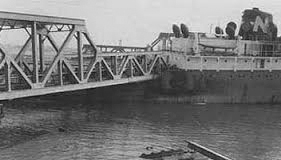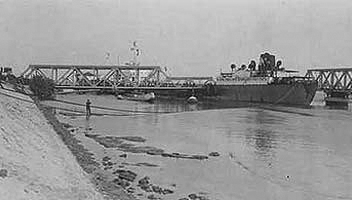















CRASH BLOCKS SUEZ CANAL
The Worst Accident In Its History
Friday, 31st December 1954
A Greek owned (Stavros Niarchos, Onassis’ brother in law and competitor) oil tanker, the “World Peace”, smashed into an open swing bridge, blocking the strategic waterway more effectively than bombs did in World War II. By nightfall 70 ships were jammed up at the ends of the waterway. The Canal engineers estimated it might take until next Wednesday to get navigation started again. Seven ships were trapped inside the Canal.
The 10,892 tons tanker World Peace, under Liberian registry but owned by a Greek Company headed by the brother in law of shipping magnate Aristotle Onassis, veered into the open arms of the swing bridge while going through early Friday morning. First reports indicated the ship’s steering gear had jammed. One entire span of the bridge at El Firdan, nine miles north of Ismailia, became snagged on the superstructure of the World Peace and was carried 50 yards north of the bridge. There the span and tanker wedged themselves on to the west bank of the Canal.
The bridge is a double-spanned swing type with an opening of 197 feet. It was built by the British Army during the build-up for the Alamein campaign in North Africa during World War II to carry a rail road across the Canal. It has long been regarded as a menace to navigation, and at least two ship collisions have occurred there previously. It was to be scrapped in another month.
When the bridge is open the spans run north and south, parallel with the canal banks. The World Peace, when more than halfway through, apparently swung toward the west bank and hit one of the opened spans and carried it off the pier supports. The fact that the tanker was loaded with crude oil prevented the hundreds of workmen called from starting work immediately with acetylene torches to cut away the steel span.
Fire brigades hurried to the scene with orders to be ready to face the risk of an explosion. Although there were no casualties, the damage is described by the Suez Canal Company as “very serious”.
Three hundred more ships are on their way to the Canal. They have been warned
by radio that they must go round the Cape of Good Hope or face delays while
the wreckage is cleared.
 |
 |
 |
 |
|
|
|
|
|
 |  |  |  |
 |  |  |  |
BEHIND THE SCENES WHEN THE "WORLD PEACE" BLOCKED THE SUEZ CANAL - 31st DECEMBER 1954
As Remembered By Peter Rogers
They say history has a way of repeating itself and that has been proven on the 23rd March 2021 when the giant container vessel, ‘Ever Given’ became wedged across the Suez Canal, resulting in 422 ships queuing awaiting the dislodging of the giant vessel.
On the 31st of December 1954 a Liberian tanker rammed a steel bridge across the Suez Canal and company officials announced the waterway would be closed for the next eight days for repairs. The 10,892 ton tanker ‘World Peace’ stuck fast broadside across the channel at El Firdan about 50 miles south of Port Said.
A large section of the bridge was torn free and dropped onto the deck of the ship but there were no casualties. Canal Company officials said the waterway would be closed to all ships for eight days whilst very important damage was repaired. The tanker was en route to Gibraltar from Kuwait.
On January 2nd it was reported from Port Said that a seagoing traffic jam at the blocked Suez Canal was growing worse by the hour. About 100 ships were piled up at both ends of the shipping bottleneck between the east and the west of the canal and at least that many more were approaching.
Canal authorities appealed to shipping companies to order their vessels slow their approach to the Suez Canal, one of the busiest waterways in the world which had been blocked since New Year’s Eve. Canal officials announced that engineers would take three more days to unplug the canal and they cabled the Suez Canal Company in London that they expect it would be open for traffic on Tuesday morning. The tanker was laden with 17,000 tons of crude oil when it knocked down the railway bridge on Friday.
The two spans of the swing bridge have to be opened like a gate to permit vessels to pass. The vessel struck the western span which collapsed and locked across the ship’s deck and was then dragged 90 feet and ploughed its bows 12 feet deep into sands on the western shore.
Thousand of passengers aboard the stalled ships went ashore for a rollicking New Year celebration which turned Port Said and Suez into festival towns.
Engineers worked day and night with acetylene torches, cutting up the bridge and a giant floating crane was taking away the pieces. British army fire fighters were rushed to the scene in case the tanker’s crude oil caught fire. A total of 38 ships were held up in Port Said harbour, among them were 2 passenger liners, 16 cargo ships, 18 tankers, a British troopship and a British destroyer. The new P & O Iberia (29,600 tons) with 1,000 passengers on board was among the ships affected by the accident; she had left London for Australia on Christmas Eve and was due at Port Said on New Year ’s Day.
On the day these ships were stranded I was on detachment at the United Services Officer’s sailing club based at Nefisha lagoon and we couldn’t wait to investigate the vessels so we piled into a small motor boat, entered Lake Timsah and cruised round the stricken ships. The first one we approached was Polish and was strictly guarded and we were warned off by a loud hailer not to approach, which was exactly what we did.
The next we tried was a Norwegian tanker and we were made most welcome in the crew’s dining area. One of the crew offered us a drink and our hearts sank when he produced a porcelain tea pot and proceeded to pour a clear liquid into pot mugs. It nearly blew our heads off!! All Norwegian ships were ‘DRY SHIPS’. No alcohol allowed. Someone had forgotten to tell the crew and they had set up an illicit still in the engine room.
After our Norwegian interlude our next, and final, visit of the night was to an Italian "Liberty" ship. So called, I was informed, because they were completely welded instead of being riveted which increased speed of production but also required less qualified team of builders and when it had sailed across the Atlantic and delivered its’ cargo it could be dismantled and the steel reused for another purpose.
We were made to feel most welcome at a boisterous party in the captain’s quarters and one of our party who had served in the merchant navy was amazed to see the lowliest of crew members joining in with the officers. The ship was called the ‘Navarro Sauro’ and was one of the last of the Liberty ships still in existence, and from comments made by the crew; it was not an easy life on that particular vessel.
The ship was sailing from Nauru in the Pacific and was carrying a cargo of guano to the U.K... Apparently the island was made entirely of guano which in my dictionary informs me is "sea fowl manure" and the passenger list was made up of the British site manager of the guano mine and his wife and two sons, the chief engineer of the mine and the mine’s Australian nurse who had had enough of the blxxxy place (her words) and was visiting the U.K. to get the smell out of her nostrils. She was rather a big girl and the ship’s chief engineer’s major hobby was winding her up by doing a chicken impression to highlight the fact that in her home state of Queensland all the pubs closed at 6pm and then they all had to go home and jump back on their perches and go to sleep. This guy seemed to fancy his chances with Frances and was a very determined Latin would-be lover, another source of irritation to her. On another evening on one of our follow up visits he played his guitar and sang a very sentimental ditty to her. As he leaned towards her and whispered some sweet nothings in her ear she grabbed the guitar and smashed it over his head, and they had to be separated before she killed him.
The ship had been on the way from Nauru for several months because when she put into Indonesia, a revolution had broken out and the boat had been tied up at the dockside, which resulted in the passengers running out of money with no access to banks or shops and there were shortages of a lot of things. Neither the ladies nor gentlemen had underwear or shirts and were not allowed ashore so we received a shopping list. Fortunately we were accompanied by several ladies from the local sailing club so our blushes were spared and we visited the shops in Ismailia to fill the lists.
We had been drinking on board the ships for several days so we wished to pay for the clothes and toiletries but they would not have it and so we came back to shore with crates of "Ruperts New York Knickerbocker Beer".
I wonder what went on behind the scenes this time when the canal was closed?
I hope my memories have proved entertaining. I have certainly enjoyed delving
back into the past and being twenty years old again.